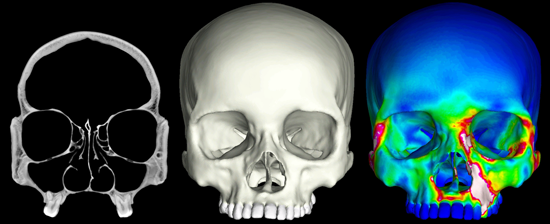Humans pack an efficient bite, but at a cost

New work by an international team of researchers shows that the cranium of modern Homo sapiens is poorly-suited to produce large biting forces due to an important limitation involving the jaw joint. The findings are consistent with the theory that as early humans developed processing techniques that both softened food and allowed it to be stored, there was less environmental pressure to maintain the higher bite force of our ancestors and primate relatives. It may also help explain modern humans' flatter, slender faces.
Compared with our closest living primate relatives, the human skull is quite striking in its appearance. In addition to our unusually large brains, humans have small jaws, teeth, and faces that are thought to reflect a diet of cooked, sliced, or softer foods. However, the human skull presents a puzzling contradiction: our small and flat faces offer increased efficiency, or leverage, to the muscles involved in biting and chewing, which is something usually found in animals that subsist on foods that are difficult to chew or crack open.
"We found that humans have high biting leverage, which some previous studies have noted, but we also found that humans are at risk of dislocating, and possibly damaging, the jaw joint during powerful molar biting," said Justin Ledogar, lead author and researcher at the University of New England in New South Wales, Australia, who conducted the study while completing his doctoral degree at UAlbany. "Additionally, we found that the human facial skeleton is generally weaker during biting than chimpanzees, which is not surprising given our small faces."
The researchers interpret our results to suggest that human craniofacial evolution was probably not driven by selection for high magnitude unilateral biting, and that increased jaw muscle efficiency in humans is likely to be a secondary byproduct of selection for some function unrelated to forceful biting behaviors. These results are consistent with the hypothesis that a shift to softer foods and/or the innovation of pre-oral food processing techniques relaxed selective pressures maintaining craniofacial features that favor forceful biting and chewing behaviors, leading to the characteristically small and slender faces of modern humans.
The paper was published in the journal PeerJ. It describes biomechanical testing of computer-based models of human crania. The methods used in the new study are similar to those used by engineers to test whether machine parts or other mechanical devices are strong enough to avoid breaking during use.
"This limitation on forceful biting appears to be much more pronounced in modern humans than in chimps or many of our fossil ancestors," said Ledogar, who graduated from UAlbany in 2015. "And because the need to bite powerfully is very unlikely to have led natural selection to favor a facial configuration that puts the feeding system at risk of being compromised, the flat faces of modern humans are probably unrelated to such behaviors."
The study does not directly address why the human face is so flat, if unrelated to powerful biting.
"We suspect that limitations on producing high bite forces may have characterized the origins of our genus," Ledogar said. "Going forward, it will be important to examine the various hypotheses that attempt to explain human facial flatness. There are a few different ideas, but we're really not sure what was driving this unusual characteristic."
More information: PeerJ, peerj.com/articles/2242.pdf
Journal information: PeerJ
Provided by University at Albany



















